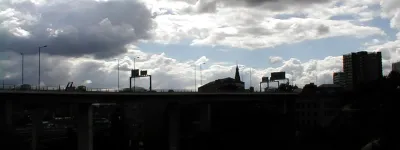Roads.org.uk is full of stories and discussion about the history of the road network. But to make sense of it all, it's important to understand the basic timeline of events to put it all into context. Here, then, is a potted history of Britain's road network from the turn of the twentieth century to the present.
- 1914
- The Road Board is set up to build and maintain roads
- 1922
- Roads are numbered for the first time
- 1958
- The UK's first motorway opens at Preston, Lancashire
- 1969
- The first 1000 miles of motorway are completed
- 1976
- Oil crisis: emergency speed limits are enacted and road building slows
- 1986
- Margaret Thatcher opens the final section of the M25
- 1993
- Protests at Twyford Down change the way Governments approach roadbuilding
- 1997
- New Labour introduce the "New Deal for Transport"
- 2001
- The first tolled motorway opens around the north of Birmingham
Making a start
The motor car first became a real concern for the authorities just before the Great War, when the inadequacy of the unsurfaced and largely unmaintained road network was acknowledged by the government. They reacted by setting up the Road Board, which collected taxes from motorists and spent the money on surfacing and improving the roads.
The main problem that the Road Board faced was not financial - its members acknowledged that the taxes they collected left them swimming in funds. The problem was actually that they couldn't spend the money fast enough. A substitute for real action was found in simply having as many roads metalled as possible, with relatively few improvements, bypasses or new alignments being considered.
The Board began to address this in 1914 by carrying out the preliminary work necessary to classify the roads of the United Kingdom, through extensive traffic surveys, and it was hoped that eventually this would give them a clear picture of which routes required prioritisation and where actual improvement work was needed.
The delays caused by the First World War and the lethargic progress of the Board led to the government starting to help itself to what should have been ringfenced funds. Eventually, deciding the Board was too slow, the government replaced it with the Ministry of Transport. The new body was much more powerful but didn't have the luxury of a guaranteed income. Nonetheless, it completed the surveys, classified the road network and gave the roads numbers that helped to organise its maintenance and also aided navigation. The system of A and B roads was unveiled to much acclaim in 1922.
Between the wars, progress on the road network was accelerated, but still really quite slow. London gained a number of new dual carriageways running out of the city to the countryside (but rarely any further), with grand names like the A4 Great West Road. The industrial north saw the occasional new route, like the A580 Liverpool to East Lancashire Road, the Queensway Tunnel under the Mersey (both opened 1934) and a handful of others. This progress was, of course, halted immediately on the outbreak of war.
The new post-war Britain
With thanks to Emrys Jones, Danny Turner, Paul Aston and Andy for corrections to this page.
